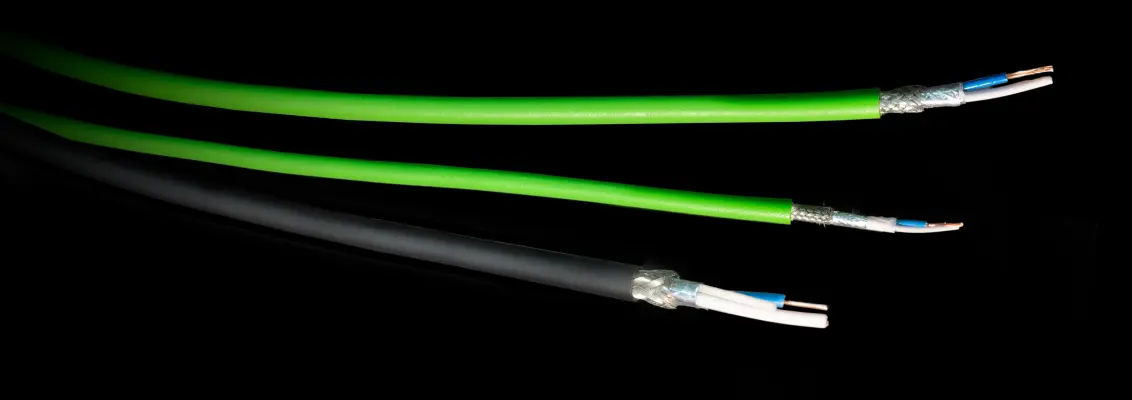Cables for Single Pair Ethernet: Where Are We Headed?
Which SPE solutions are preferable against existing communication standards?

Single Pair Ethernet (SPE) is seen as one of the most important trends shaping the future of industrial communication. Advantages of this new connection technology featuring only one conductor pair include high-speed data transmission, reduced space requirements and lower costs. But where will it be applied in the future, which cable types will be required, and how will SPE perform compared to existing communication standards? HELUKABEL addressed these questions in a webinar titled "Single Pair Ethernet Cabling", which took place as part of the "SPE Pioneer Summit" webinar series.
Currently, various communication systems can be found in the industrial environment, such as Profinet , CAT 5e and 6a , Industrial Ethernet or Ethercat . However, Single Pair Ethernet has the potential to replace these technologies in numerous applications - thanks to data transmission at gigabit speeds and a simultaneous power supply via only one wire pair. This smart, flexible, cost and space saving solution makes real-time communication possible down to the field level.
A basic prerequisite for the use of SPE is to have the right technical infrastructure in place - from terminals and plug connections to cabling. In order to make the changeover easier for manufacturers and users, the same cable classifications were defined for SPE as are already used for Profinet:
- Type A: wires with solid wire for permanent installation
- Type B: wires with stranded conductors for flexible applications or vibrations
- Type C: wires with stranded conductors for high dynamic applications (such as drag chains)
- Type R: torsion tested cables with stranded conductors for robotic applications
Drag chain and robot cables mainly differ by their respective screening designed for bending or torsional load capacity.
In addition, different sheath materials are used for each cable type to suit specific applications. Cables of type A and B are typically screened with PVC. There are also plenty of halogen-free, food safe and oil and chemical resistant alternatives to choose from. Type C cables are available in PUR, PVC and Santoprene, and type R robot cables are also available in PUR and Santoprene.
| Jacket | Halogen-Free | Flame Retardancy | Low Smoke | Price | Oil Resistance | Repeated Bending | Abrasion Resistance | UL Flame Test Possibilities |
| PVC UL | no | medium-high | no | low-medium | low-high | medium | medium | VW1, FT1, FT4 |
| FRNC/LS0H/ LSZH | yes | medium-high | yes | medium | low | low | low | VW1, FT1, FT4 |
| PE | yes | no | yes | medium | low | low | low | no |
| PUR UL | yes | medium | medium | high | high | high | high | VW1, FT1, CFT |
| TPE (Santoprene) | no | medium | medium | high | high | high | high | VW1, FT1, CFT |
| TPE (Santoprene) | yes | no | medium | high | high | high | high | no |
Table 1: Properties of different sheath materials of SPE cables
For data transmission, Single Pair Ethernet offers several options in terms of speed and range:
- 10BASE-T1: data rate up to 10 Mbit/s, range up to 1.000 m
- 100BASE-T1: data rate up to 100 Mbit/s, range up to 40 m
- 1000BASE-T1: data rate up to 1 Gbit/s, range up to 40 m
- MultiGigBASE-T1: data rate up to 2,5 / 5 / 10 Gbit/s, range up to 15 m
In the industrial environment, 10BASE-T1 and 1000BASE-T1 are currently the most important. The MultiGig technology, which is still being developed, will open more possibilities in the future. HELUKABEL has already added three different SPE cables for 10BASE-T1 and 1000BASE-T1 to its portfolio, and the product range is constantly being expanded.
When comparing different existing industrial communication technologies with Single Pair Ethernet, many advantages become apparent depending on the application. For example, 10BASE-T1 scores more highly than Profibus PA with its significantly higher frequency range, which enables a data transmission at up to 320 times the speed - fast enough for the transmission of videos, for example.
| Profibus PA / Foundation Fieldbus | SPE 10BASE-T1L | |
| Cross Section | AWG 18 solid or stranded / AWG 16 stranded | |
| Max. Distance | up to 1900 m non harzardous areas, up to 1000 m in hazardous areas (FISCO Power Supply to IEC 60079-11) | up to 1000 m (TI phy DP83TD510E > 2000 m Peer-to-Peer) |
| Impedance | 100 +- 20 ohms @ 31,25 kHz | 100 +- 15 ohms @ 20 MHz |
| Frequency Range | up to 39 kHz | up to 20 MHz |
| Max. Data Rate | 31,25 kbit | 10 Mbit |
| Typical Connector | M12 a-coded 4 PIN IP67 7/8 inch PI67 | M8/M12 SPE IEC 63171-6 |
Table 2: Comparison of SPE 10BASE-T1 with Profibus PA
Compared to USB technology, both 1000BASE-T1 and MultiGigBASE-T1 offer a significantly higher data rate and range as well as a greater power supply. 1000BASE-T1 is also preferable due to its smaller cable diameter and lower weight, lower copper requirement and tighter bending radii than cabling with Profibus DP, CAN or Industrial Ethernet.
| Comparison | Profibus DP | SPE 1000BASE-T1 | SPE 1000BASE-T1 | SPE Advantage or Disadvantage |
| Drag Chain Design | Drag Chain Design | Drag Chain Design | ||
| Cross Section | AWG 23/19 | AWG 26/19 | AWG 22/19 | |
| Data Rate | 12 Mbit | 1 Gbit | 83x more data rate | |
| Cable Diameter | 8,0 mm | 4,9 mm | 6,3 mm | 21-38% reduced space |
| Max. Distance | 100 m* | 40 m | disadvantage in length | |
| Power | no(hybrid) | PoDL up to 50 W | power included | |
| Cable Weight | ~ 77 kg/km | ~ 29 kg/km | ~ 50 kg/km | 35-60% reduced weight |
| Copper Fig. | 25 kg/km | 16 kg/km | 24 kg/km | 4-36 % reduced copper |
| Bending Radius Chain | 96 mm | 59 mm | 76 mm | 20-39% red. bending radius |
*with high speed 12 Mbit
Table 3: Comparison of SPE 1000BASE-T1 with Profibus DP
You can find out more information in the "Single Pair Ethernet (SPE) Cabling" webinar that HELUKABEL recently did as part of the SPE Industrial Partner Network's "SPE Pioneer Summit" series. HELUKABEL expert Horst Messerer delivers a detailed presentation about the advantages of SPE technology compared to existing communication standards and explains which cables and connectors are already available on the market. The webinar can be accessed free of charge at any time here .

